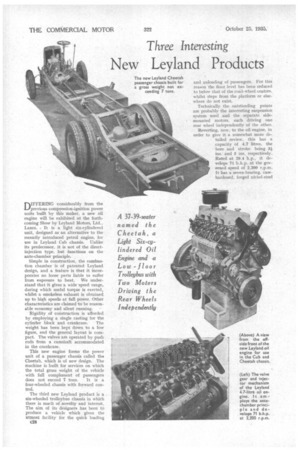Three interesting
Page 70

Page 71

If you've noticed an error in this article please click here to report it so we can fix it.
New Leyland Products
r IFFERING considerably from the Liprevions compression-ignition power units Innli 'by this maker, a new oil engine will be exhibited at the forthcoming Show by Leyland Motors, Ltd.,
Lancs. It is a light six-cylindered unit, designed as an alternative to the recently introduced petrol engine, for use in Leyland Cub chassis. Unlike its predecessor, it is not of the directinjection type, but functions on the ante-chamber principle.
Simple in construction, the combustion chamber is of patented Leyland design, and a feature is that it incorporates no loose parts liable to suffer from exposure to heat. We understand that it gives a wide speed range, during which useful torque is exerted, whilst a smokeless exhaust is obtained up to high speeds at full power. Other characteristics are claimed -to be reasonable economy and silent running.
Rigidity of construction is afforded by employing a single casting for the cylinder block and crankcase. The weight has been kept down to a low figure, and the general layout is compact. The valves are operated by push rods from a camshaft accommodated in the crankcase.
This new engine forms the power unit of a passenger chassis called the Cheetah, which is of new design. The machine is built for services on which the total gross weight of the vehicle with full complement of passengers does not exceed 7 tons. It is a four-wheeled chassis with forward control.
The third new Leyland product is a six-wheeled trolleybus chassis in which there is mw-,h of novelty and interest. The aim of its designers has been to produce a vehicle which gives the utmost facility for the quick loading and unloading of passengers. For this reason the floor level has been reduced to below that of the road-wheel centres. whilst steps from the platform or elsewhere do not exist.
Technically the outstanding points are probably the interesting suspension system used and the separate sidemounted motors, each driving one rear wheel independently of the other.
Reverting, now, to the oil engine, in order to give it a somewhat more detailed review, this has a capacity of 4.7 litres, •the bore and stroke being 3i ins. and 5 ins. respectively. Rated at 29.4 h.p., it develops 71 b.h.p. at the go-verned -speed of 2,200 r.p.m. It has a .seven-bearing, casehardened, forged nickel-steel crankshaft, balanced statically and dynamically, and incorporating an oscillation. damper.
The crankpins .are .2,1 ins, in diameter, and the steel connecting tods have aluminium-alloy I, top-half '.bearings. Screwed-in valve scats are used, those for the exhaust valves being Stelaefaced, Of C.A.V.-Bosch make, the injection system is of the. fixed-timing type..
Features of the Cheetah chassis in
elude a frame. with 11-in. !members; Lockheed servo-assisted brakes, and 15I-in.-diameter drums. I•
The wheelbase of thi5 machine is 17 ft. 7 ins., whilst the chassis weighs 3 tons 2 cwt. 1 qr.
An accompanying drawing shows diagrammatically the layout of the trolleybus. The interesting separate drive system will he observed. At the rear, dropped axles are employed. The ends of these carry worm-gear
boxes provided with extensions on which the hubs revolve on tapered roller bearings. The drive is transmitted from the worm-wheels to the hubs by short live axles.
The • arrangement permits a saloon with a very low central gangway to be employed.There is an• entrance at both the front and the rear, and the,whole design repreSents a definite effort to solve the problem of speeding up the entry and departure of passengers.
















































































































































